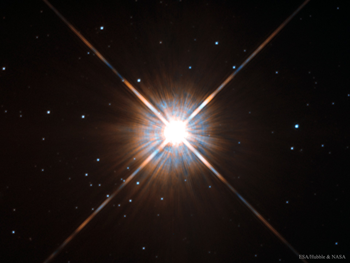Scientists consider how to visit the closest exoplanet
Even at only around 4 light-years, a trip from Earth to Proxima b might still take tens of thousands of years

A trip on any spacecraft big enough to take passengers would last longer than any human could survive.
3DSculptor / iStockphoto
By now, you probably have heard that astronomers have discovered a new exoplanet orbiting the star closest to our sun. That star, Proxima Centauri, is 4.2 light-years away. In miles, that’s like 25 trillion.
The new planet’s name is Proxima b. Because its star is so relatively close, some people wonder whether it would be possible to go there. And it is possible, in a way. But it would take a very long time. Even at the speed of light, it would take more than four years to go from Earth to the new planet (and no spaceship can go nearly that fast). New Horizons is the spacecraft that flew past Pluto. At 16 kilometers (10 miles) per second, it’s the fastest vehicle that humans have launched. That was good enough to get to Pluto in nine years. But at that speed it would take almost 80,000 years to get to Proxima b.
In science fiction stories, of course, a warp drive or some other invention allows a spaceship to go faster than light. Then you could get to Proxima b easily. But in real life, nothing can go faster than light, and the best rockets can’t even come close.

Scientists do have ideas for building ships that could do better than those available today. Rockets work by expelling their fuel’s exhaust behind the vehicle. That propels the rocket forward because for every action there is an equal and opposite reaction. (That’s Isaac Newton’s third law of motion.) To go forward faster, then, you need to expel your fuel’s exhaust faster backward. One plan to do that would use electrically charged atoms to create a plasma engine. Its exhaust could speed away at 50 kilometers (about 30 miles) per second. That would make it a few times faster than the New Horizons probe.
Another very new idea would use radioactive matter. Many unstable atoms produce a specific form of radioactivity known as alpha particles. When an atomic nucleus spits out alpha particles, they can zip away 300 times faster than the exhaust of a plasma engine.
But to power a spaceship with alpha particles, you’d need a good supply of their radioactive source. Uranium might work. It comes in different forms, called isotopes. Some of them would be better than others. Perhaps the best of these, uranium-232, is not found in nature. It can be produced from other elements, however, by carrying out the right nuclear reactions.
Alpha particles usually fly off in all directions. So to power a ship, you would need a material that stops the particles flying off in one direction. Those free to fly the other way (the exhaust) would drive the ship forward (via that opposite but equal reaction, again).
Because alpha particles are tiny, an alpha-powered ship would start out slow. (In fact, you would have to shoot it into space to begin with, powered by an ordinary rocket.) But in space, with nothing to slow it down, the alpha ship would gradually gain speed. Eventually it might reach 200 to 300 kilometers (some 125 to 185 miles) per second.
In a scientific report about this plan, researchers from China say an alpha-powered ship could reach Proxima Centauri in 4,000 to 9,000 years. The exact time would depend on how much weight was onboard compared with how much fuel the ship carried. That’s much faster than other propulsion systems. Still, nobody onboard the ship when it departed would still be alive when it arrived.
It might be possible, though, to send tiny spacecraft to Proxima Centauri much more quickly. And even a craft too small to carry passengers might still be big enough to hold cameras that snap pictures of the new world.

One group has proposed such a plan. A wealthy Russian named Yuri Milner and the famous physicist Stephen Hawking announced a project to study whether very small “nanocraft” could be sent to the Alpha Centauri system. (Proxima Centauri is one of three stars in that system.)
Their plan would be to build tiny cameras and lasers onto a wafer weighing about as much as a dime. Attached to the wafer would be a very thin material, sensitive to laser light. That would act as its sail. Pressure from a powerful laser beam could propel the sail-wafer. Scientists working on the plan think they might be able to drive a fleet of such wafers toward Proxima Centauri at one-fifth the speed of light. At that rate, the wafer crafts might reach Proxima b in 20 years or so. Then they could use their laser to send data about the planet back to Earth.
Nobody knows for sure whether this plan will work. Even if it does, building a ship that fast — but big enough to carry people — would be much, much harder. And it might not be such a good idea. A real ship (say the size of the space shuttle) flying at a fifth the speed of light would be very dangerous. If something that size crashed into Earth, it would release the same amount of energy as millions of atomic bombs. If any intelligent beings living on Proxima Centauri saw such a ship heading their way, they might get pretty nervous.